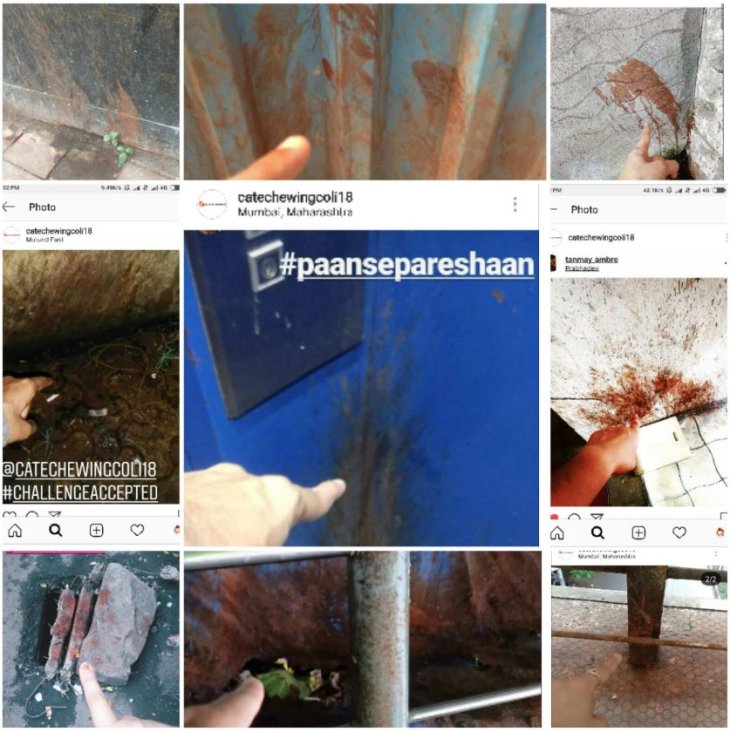8 Mumbai Girls Totally Remove Paan Stains In An Eco-friendly Way
Ishwar Chadda - Nov 15, 2018

Now paan stains can be removed totally and safely, all thanks to eight Mumbai girls.
- Uber Said Mumbai Is The 'Most Forgetful' City, And Here's Why
- Mumbai Police Catches Criminals Using Biometric Data
- Mumbai: A Guy Fell Down From A Building While Taking A Selfie
When you come to India and take a walk on the road, you will easily see paan stains on the streets, roads, and billboards. If you pay attention, you will see whether people are motorcyclists, draggers, even taxi drivers, they spit all around you when the car stops to wait for the red light.
Indian men have maintained this habit for a long time, and they are determined not to give up. Four years ago, Swachch Bharat Abhiyan launched by Prime Minister Narendra would not ever bear fruit until we get rid of the paan stains that are spoiling the historical monuments of the nation and the walls of our vicinity.

When the betel leaves are plucked down the road, they will stick for a long time. Rainwater can only make the stain color smoother. We all know that when the betel stain on clothes cannot be cleaned.
Thus, finding the method of stain removal is a big problem for Indians. A group of eight girls from Mumbai's Matunga have found a solution to remove stains from betel leaves. In particular, this solution is cheap cost and environmentally friendly.

The girls were inspired by the PM's cleanliness movement. They have discovered that microbes and enzymes convert the red color of paan into a 'harmless colorless product'. Sanika Ambre, a member of the group, told Times Of India that they would use enzymes in the form of the gel to remove stains.
Shrutika Sawant, one of the final-year BSc microbiology students from the team told TOI, "we investigated the ingredients that created the red of paan through meetings with paan suppliers. We found that limestone and catechu are the cause of reddish brown. We also met the toilet workers to find out their difficulties when cleaning paan stains. We contacted chemical companies to find out about the chemicals used for cleaning."

How much water and Acid Wasted to remove the stain of paan?
During the study, the girls from Ramnarain University contacted many professors, paan providers, and road managers. They calculated that on average of the Soon station needs 10 liters of acid per month for cleaning.
Smaller stations usually require three to four different detergents. Larger stations must hire a cleaning agency from the outside. They will be in charge of cleaning the whole station.
With help from the press, the team calculated that 60,000 liters of water were used to clean the paan stains. However, the girls' new solution will save a lot of water.

The team was felicitated for its innovative idea by Maharashtra CM, Devendra Fadnavis. The team won the prestigious gold medal at iGEM 2018. Ramnarain is the only university to receive the award for the most useful research for man.
The girls have received a grant of Rs 10 lakh. The team has implemented anti-spitting drives with the title '#paan se pareshaan' to raise awareness and to continue the plan with it. The students hope to receive other grants for better project development.
The research team included Mitali Patil, Maithili Sawant, Nishtha Pange, Komal Parab, Anjali Vaidya, and Aishwarya Rajurkar.
Featured Stories

Features - Jul 01, 2025
What Are The Fastest Passenger Vehicles Ever Created?

Features - Jun 25, 2025
Japan Hydrogen Breakthrough: Scientists Crack the Clean Energy Code with...

ICT News - Jun 25, 2025
AI Intimidation Tactics: CEOs Turn Flawed Technology Into Employee Fear Machine

Review - Jun 25, 2025
Windows 11 Problems: Is Microsoft's "Best" OS Actually Getting Worse?

Features - Jun 22, 2025
Telegram Founder Pavel Durov Plans to Split $14 Billion Fortune Among 106 Children

ICT News - Jun 22, 2025
Neuralink Telepathy Chip Enables Quadriplegic Rob Greiner to Control Games with...

Features - Jun 21, 2025
This Over $100 Bottle Has Nothing But Fresh Air Inside

Features - Jun 18, 2025
Best Mobile VPN Apps for Gaming 2025: Complete Guide

Features - Jun 18, 2025
A Math Formula Tells Us How Long Everything Will Live

Features - Jun 16, 2025
Comments
Sort by Newest | Popular